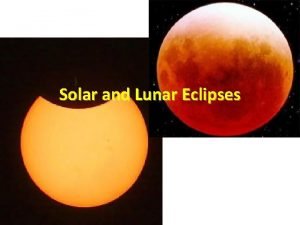Eclipse 2017 Offers Unique Opportunity for Science Investigations

- Slides: 1

Eclipse 2017 Offers Unique Opportunity for Science Investigations The 2017 total solar eclipse on August 21 will be one of the best-observed solar eclipses to date. Total Solar Eclipses provide unique conditions for studying Earth, the sun, and their interaction. Because of its long path over land, scientists will be able to make ground-based observations over more than an hour on 8/21/17 to complement the data provided by NASA satellites. The 11 NASA-funded studies cross a range of disciplines, using the total solar eclipse to observe our sun, Earth, and the planet Mercury, test new instruments, and even leverage the skills of citizen scientists to expand our understanding of the sun-Earth system. § Exploring Coronal Physics through Imaging Spectroscopy § Temperature and Flow Speed in the Solar Corona § Interdisciplinary Airborne Science from NASA's WB-57 § Measuring the Infrared Solar Corona § Citizen Science Approach to Measuring the Polarization of Solar Corona § Rosetta-stone experiments at infrared and visible wavelengths § Solar eclipse-induced changes in the ionosphere over the continental US § Ionization sources on the formation of the Dregion ionosphere § Empirically-Guided Solar Eclipse Modeling § A 3 -D radiative transfer closure experiment § Land Atmospheric Responses The institutions that will facilitate this research include the Universities of Hawaii, Colorado – Boulder, and Missouri, the Massachusetts Institute of Technology, and Virginia Tech; the University Corporation for Atmospheric Research, the Southwest Research Institute, the Space Sciences Institute, and NASA’s GSFC and JSC. Top left: Solar corona taken during the 20 March 2015 solar eclipse. Credit: S. Habbal, M. Druckmüller and P. Aniol; Above: Visualization of the 2017 total solar eclipse. Credit: NASA SVS

